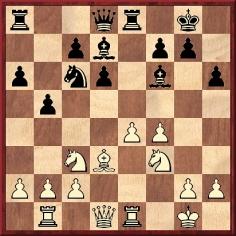
When contacting us by e-mail, correspondents are asked to include their name and full postal address and, when providing information, to quote exact book and magazine sources. The word ‘chess’ needs to appear in the subject-line or in the message itself.
| First column | << previous | Archives [40] | next >> | Current column |
In the ‘secret game’ between Reshevsky and Muffang the moves are available only as from this position:

We have received from correspondents two reconstructions of the opening phase (other possibilities exist, of course):
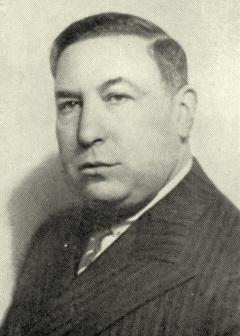
Akiba Rubinstein
Roland Kensdale (Aberdeen, Scotland) quotes the following passage about Rubinstein from page 168 of Russian Silhouettes by Genna Sosonko (Alkmaar, 2001):
‘His nurse, madame Rubin-Zimmer, remembered: “He was an unusually calm and self-controlled person. He was easy to look after. Physically he was exceptionally strong and very healthy for his age. But from time to time he would behave strangely. For days on end he would not come out of the room for even a short walk. Or sometimes in the evening he would not want to go to bed. Then he would sit in the armchair next to the bed and meditate deeply about something or move the pieces on a pocket chess set.”
We do not know how the lessons went, when the young O’Kelly went to the clinic to visit the famous Maestro. What was Rubinstein thinking of when, in the very last period of his confinement, he would sit for a long time in front of a chess board, with the pieces set up in the initial position, sometimes making the move 1 c2-c4 and, taking the pawn back after half an hour’s thought, again looking at the chess board? What solution to the secret of the initial position did he imagine that he saw?’
Our correspondent notes that Sosonko’s book has no bibliography and does not specify the source of the above information.
What material about Sherlock Holmes and Harry N. Pillsbury was published in 1964? Some puzzling complications arise from that apparently straightforward question.
Page 23 of An Annotated International Bibliography of Chess Articles in Non-Chess English Language Periodicals 1783-1977 by Paul Richman (Old Bridge, 1978) had the following entry:

Richard Wincor’s name is familiar to Sherlock Holmes enthusiasts. He wrote Sherlock Holmes in Tibet (New York, 1968), although that book had no chess content.
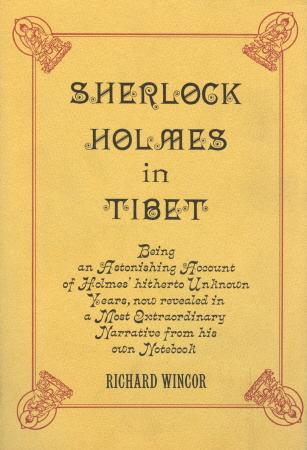
Nor have we found anything by Wincor, or about chess, in the Baker Street Journal of the time indicated by Richman.
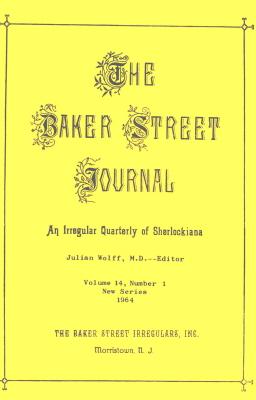
Even so, the following appeared on page 144 of Grandmasters of Chess by Harold C. Schonberg (Philadelphia and New York, 1973):
‘Hastings, 1895 then disbanded. But everybody was talking about Pillsbury. There was amazement then that an unknown should take first prize in so powerful a field. In later years theories were to be advanced. The Spring 1964 issue of the Baker Street Journal had a learned article “proving” that the great Sherlock Holmes impersonated Pillsbury at the tournament. But this theory is not generally accepted in chess circles.’
We have found that a Holmes/Pillsbury article, entitled ‘Yet Another Case of Identity’, was printed not in the US publication the Baker Street Journal but on pages 115-118 of the Spring 1964 issue of a London-based publication, the Sherlock Holmes Journal.
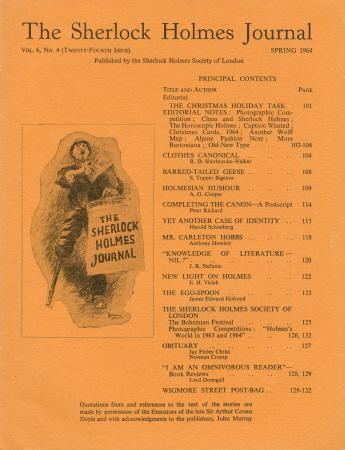
Surprisingly, the author was not Richard Wincor but Harold Schonberg himself:

At present it is unclear to us on what grounds both Richman and Schonberg mentioned the Baker Street Journal, and why Wincor was named by Richman as the author of a 1964 piece on Holmes/Pillsbury entitled ‘The Sherlock Holmes Opening’. Does it really exist, in addition to Schonberg’s article of the same year on the same theme?
C.N. 5231 quoted a claim that Kurt Richter wrote in the 1936 Deutsche Schachblätter that the Schuster v Carls combination was unsound. The full game was given on page 166 of the 1 June 1936 magazine (at the end of an article on Carls by Alfred Brinckmann), and Alan McGowan (Waterloo, Canada) notes that it was discussed further in an unsigned feature (readers’ reaction) on page 389 of the 1 November 1936 issue:
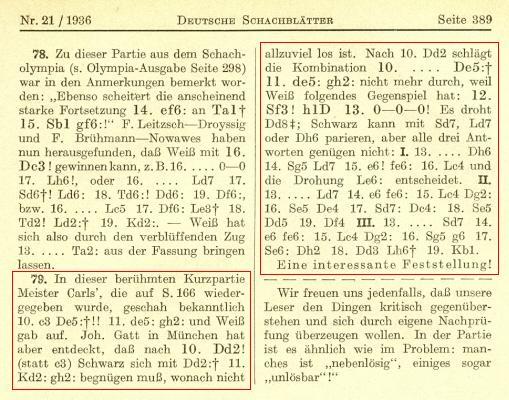
Mr McGowan also points out that page 403 of the 15 November 1936 Deutsche Schachblätter reverted to Schuster v Carls, and that this time the possibility of 10...gxf2+ was included:
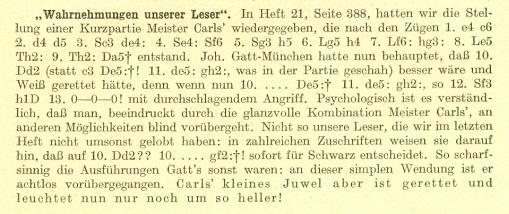
C.N. 5231 mentioned that Carlos Torre allegedly won an identical game in the late 1920s, and Christian Sánchez (Rosario, Argentina) now offers a further complication by quoting from page 98 of Emil Gelenczei’s book 200 celadas de apertura (whose publishing history was discussed in C.N. 4455):
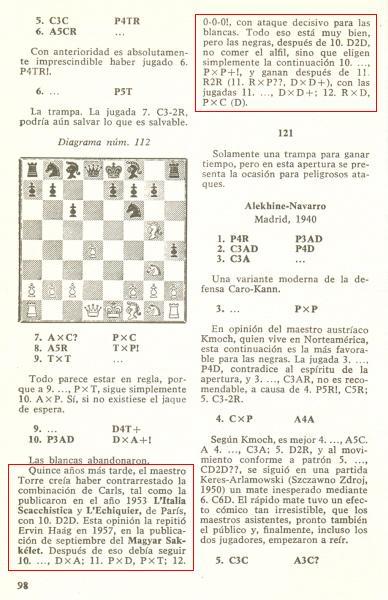
So now the claim, on the basis of two 1953 magazines, is that, 15 years after Schuster v Carls was played, Torre believed that he had refuted the combination with 10 Qd2, overlooking 10...gxf2+. The text does not suggest that Torre played the game himself.
Below is a photograph of Carl Carls watching a game in Mannheim in 1914 between Ehrhardt Post and Savielly Tartakower:
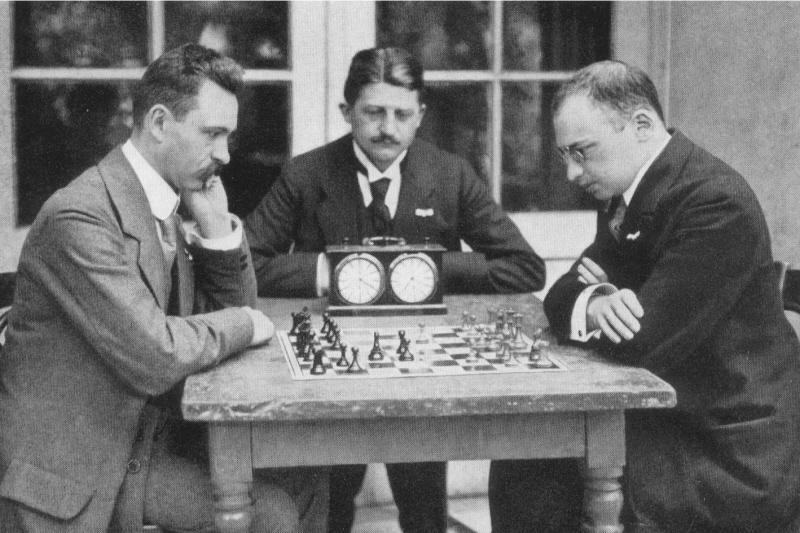
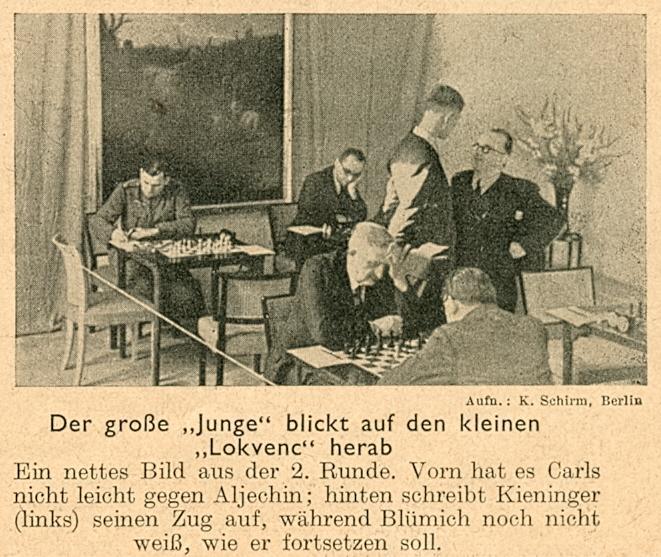
Carl Carls also appears in this photograph from page 167 of the 1 November 1941 Deutsche Schachblätter. Taken in Cracow on 7 October 1941, it shows G. Kieninger and M. Blümich in the background, K. Junge in conversation with J. Lokvenc and, in the foreground, C. Carls and A. Alekhine.
We have now found a further cutting, from an unidentified local newspaper dated 26 January 1978, with a photograph from Petrosian’s display and stating that it took him ‘a mere 135 minutes to complete 29 games against members of Ilford Chess Club last week’. On the right is Neil Carr (aged nine), and seated next to him is his 17-year-old brother, Trevor.
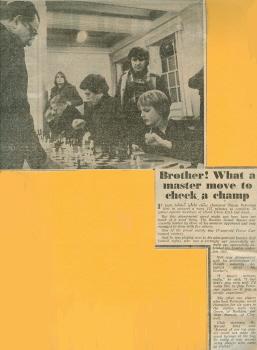
C.N. 2375 (see page 347 of A Chess Omnibus) mentioned that when annotating his game (which opened 1 d4 Nf6 2 Bg5) against Endzelins in the Munich, 1936 Olympiad on page 368 of Deutsche Schachblätter, 15 October 1936 Trompowsky wrote of the bishop move: ‘My variation, which I have been playing for more than 15 years.’
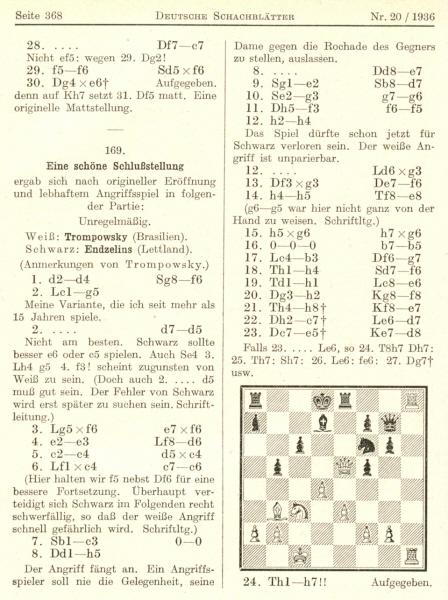
In C.N. 4306 Christian Sánchez (Rosario, Argentina) commented:
‘According to page 181 of El Ajedrez Argentino, June 1947, Octavio Trompowsky gave some games with his opening in his book Partidas de Xadrez.’
Now Eduardo Bauzá Mercére (New York, NY, USA) reports on the content of that volume, which was published in 1941. In the first note to the above-mentioned game against Endzelins, given on pages 71-72, Trompowsky wrote of 2 Bg5:
‘Um lance especialmente analizado pelo autor destas linhas, com o intúito de fugir aos livros e poder enfrentar os mestres com armas mais ou menos iguais.’ [‘A move especially analysed by the author of these lines, with the intention of avoiding the books and being able to fight against masters on more or less equal terms.’]
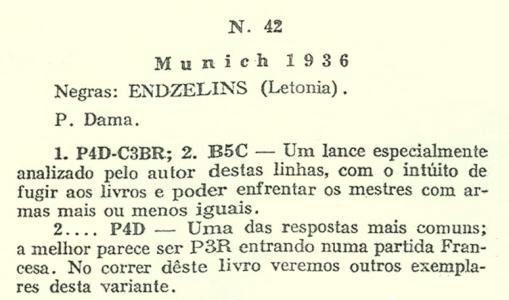
That is the book’s first specimen of 1 d4 Nf6 2 Bg5, the later cases being:
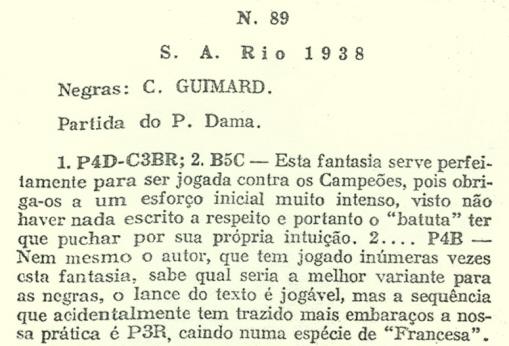
All the above-listed games were annotated by Trompowsky. His victories against Endzelins and Kiproff were played on 22 and 29 August 1936 respectively, and the former game thus remains the earliest specific instance known to us of 1 d4 Nf6 2 Bg5 being played by Trompowsky.
Mr Bauzá Mercére notes, though, that pages 43-44 feature a game played by telegraph in 1925 between Montalbán (White) and Trompowsky. It began 1 d4 d5 2 Bg5, after which Trompowsky wrote:
‘Uma fantasia interessante que Tartakower batizou de “Vôo no Azul” e que tem pelo menos o mérito de sair dos livros. Tarrasch disse algures que êste Bispo procurava pregar a sombra do Cavalo!’ [‘An interesting fantasy, which Tartakower christened a “Flight into the Blue” and which at least has the merit of leaving the books. Tarrasch said somewhere that this bishop was trying to pin the knight’s shadow!’]
Our correspondent remarks too how often José Montalbán played 2 Bg5 at Carrasco, 1921-22 and Mar del Plata, 1928. As regards the former event, for instance, the Lachaga tournament book published in 1980 shows that Montalbán’s openings with White were as follows:
Mr Bauzá Mercére also proposes tentative reconstructions of the early part of two games, to reach the starting-positions currently known:
1) Alexander v Marshall (C.N. 3508): 1 e4 e5 2 Nc3 Nf6 3 Bc4 Bc5 4 d3 O-O 5 Bg5 c6 6 f4 d6 7 Nf3 b5 8 Bb3 a5 9 a3 Qb6 10 Bxf6 Bf2+ 11 Ke2 gxf6 12 Qd2 Na6 13 Ba2 Nc7 14 g3 Ne6 15 f5 Nd8 16 Rhf1 Bc5 17 Nh4 d5 18 Qh6 d4 19 Na4.
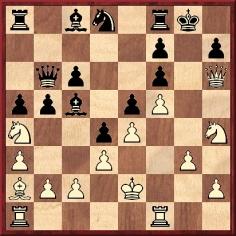
2) J.R. Capablanca v Morgan (C.N. 3778): 1 e4 d6 2 d4 Nf6 3 Bd3 Nc6 4 Ne2 e5 5 c3 Be7 6 O-O O-O 7 h3 exd4 8 cxd4 Bd7 9 Nbc3 Nb4 10 Bb1 Nc6 11 d5 Na5 12 f4 g6 13 e5 Nh5 14 g4 Ng7 15 Qd3.
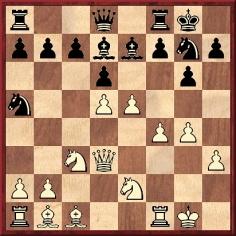
Dan Scoones (Coquitlam, BC, Canada) sends the following extract from a report on page 19 of the New York Times, 20 July 1919:
‘By invitation of the I.L. Rice Progressive Chess Club, Metropolitan League champions, Oscar Chajes, Charles Jaffe and Boris Kostić started a short three-cornered tournament at that club yesterday. The pairings brought together Jaffe and Kostić in the first round, Kostić winning the toss for move and selecting the Ruy López. The Serbian brought about an early exchange of queens, Jaffe being left in possession of two bishops. The latter won a pawn at his 24th turn, and playing in excellent style thereafter, brought about Kostić’s resignation after 48 moves had been recorded. Jaffe will play against Chajes in the next round.’
Our correspondent asks what more is known about this event and whether any games have survived.
He also points out that databases contain a lively game allegedly played by Jaffe and Kostić in New York in 1919 but which does not match the above description: 1 e4 e5 2 Nf3 Nc6 3 Bc4 Nf6 4 Ng5 d5 5 exd5 Na5 6 Bb5+ c6 7 dxc6 bxc6 8 Bd3 Bd6 9 c3 h6 10 Ne4 Nxe4 11 Bxe4 O-O 12 d4 f5 13 dxe5 fxe4 14 Qxd6 Qh4 15 Be3 Ba6 16 Nd2 Rad8 17 Qb4
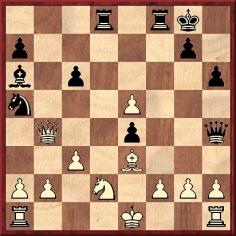
17...Rxd2 18 Kxd2 Rxf2+ 19 Kc1 Rxg2 20 Qxa5 Bc8 21 Rd1 Qh3 22 Qd8+ Kh7 23 Qd4 Qf3 24 Re1 c5 25 Qd5 Rxh2 26 Bd2 Bf5 27 e6
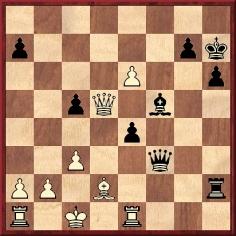
27...e3 28 Qxf3 exd2+ 29 Kd1 Bc2+ 30 Kxc2 dxe1(Q)+ 31 Kb3 Qxe6+ 32 c4 Qb6+ 33 Kc3 Qxb2+ 34 Kd3 Qd4 mate.
Information on this game is sought.
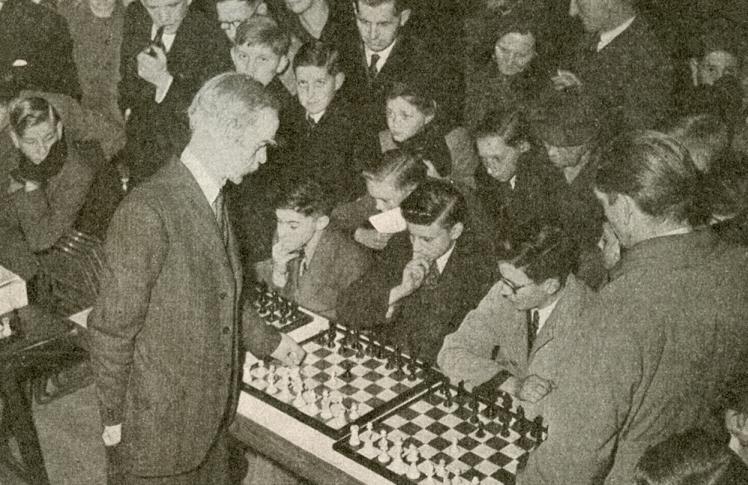
A rather easier picture question this time: who is the master?
In C.N. 3634 we asked for information about the British Chess
Bulletin, a scarce monthly publication edited by H.T.
Dickinson from October 1910 to January 1911. Nothing having been
received so far, we renew the request.
Rapid progress on this matter can be reported, thanks to Eduardo Bauzá Mercére (New York, NY, USA). He points out, firstly, that on pages 141-142 of Ambasador Šaha by D. Bućan, P. Trifunović and A. Božić (Belgrade, 1966) there are two games between Kostić and Jaffe in New York in 1919, i.e. the one given in C.N. 5263 and the following:
Boris Kostić – Charles Jaffe1 e4 e5 2 Nf3 Nc6 3 d4 exd4 4 Bc4 Qf6 5 c3 d3 6 O-O d6 7 Qxd3 Bg4 8 Bg5 Qg6 9 Nbd2 Be7 10 Qe3 h6 11 Bh4 Bxh4 12 Nxh4 Qh5 13 g3 Bh3 14 Rfe1 Nge7 15 Be2 Bg4 16 f3 Bd7 17 f4 Bg4 18 Nhf3 O-O-O 19 b4 g5 20 f5 Kb8 21 a4 f6 22 b5 Ne5 23 a5 d5 24 b6 dxe4 25 Nxe5 Bxe2 26 Rxe2 fxe5 27 bxa7+ Ka8 28 a6 b6 29 Qxe4+ c6 30 Nc4 Kxa7 31 Qxe5 Rd7
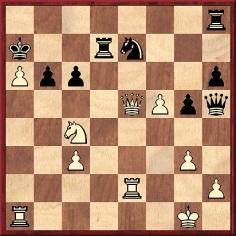
32 Qxe7 Rhd8 33 Qxd8 Resigns.
Our correspondent also provides three articles by Hermann Helms in his Brooklyn Daily Eagle column.
‘Kostić Seeking Passports
For the first time since he lost his match with Capablanca at Havana, Boris Kostić, the Serbian champion, put in an appearance in this city yesterday, visiting both the Manhattan Chess Club and the I.L. Rice Progressive Chess Club, where friends greeted him and tendered their condolences. Kostić in the interim has been at his home in Gary, Ind., where, like many another notable, he has been putting in a part of his time chopping down trees on his father-in-law’s farm. Although this exercise at the start yielded a fine crop of blisters, it was, nevertheless, fine training for the chess master, who is planning to go abroad to take part in the Victory Tournament of the British Chess Federation at Hastings, 11-23 August.
Kostić looked a bit thinner than when he was here last, but he says he lost 18 pounds while in Havana, nor was he sorry to lose it. He is down to fighting weight, so to speak, and, with an ocean voyage thrown in, he will be fit to do himself full justice when the Mayor [of] Hastings officially declares the international masters’ tournament under way.
The purpose of Kostić’s visit is to obtain the necessary passports to enable him to get across ...’
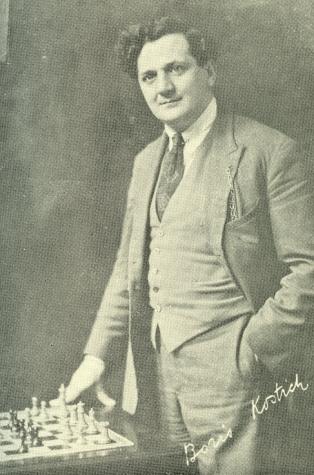
Boris Kostić
‘Kostić in training
‘Boris Kostić, preparatory to his departure for England next Saturday, is making the most of his brief stay in New York by getting as much practice as possible at the rooms of the I.L. Rice Progressive Chess Club, twice winner of the Metropolitan League championship. His chief opponent has been Charles Jaffe, with whom he has contested a number of games for purses provided by the members and has been successful in the majority. Two specimens of their play are appended, together with one wrested from Jaffe in a similar game by Oscar Chajes.’
Below are the three games:
Boris Kostić – Charles Jaffe1 e4 e5 2 Nf3 Nc6 3 Bb5 a6 4 Bxc6 dxc6 5 d4 exd4 6 Qxd4 Bg4 7 Be3 Qxd4 8 Nxd4 c5 9 Ne2 O–O-O 10 Nd2 f6 11 f3 Be6 12 O-O-O b6 13 Nf4 Bf7 14 Nb3 Bd6 15 Nd5 Ne7 16 c4 Ng6 17 g3 Ne5 18 Nd2 Rhe8 19 Kc2 Kb7 20 b3 Nc6 21 a3 Nd4+ 22 Kb2 Be5 23 f4 Bd6 24 Nc3 Bh5 25 Rde1 Nf3 26 Ref1 Nxd2 27 Bxd2 Bf8 28 Kc2 c6 29 h3 b5 30 g4 Bf7 31 cxb5 axb5 32 Rf2 b4 33 axb4 cxb4 34 Na4 Rxe4 35 Re1 Rxe1 36 Bxe1 c5 37 Rd2 Rxd2+ 38 Bxd2 Kc6 39 Nb2 Kb5 40 Be3 c4 41 Bd4 Bd5 42 bxc4+ Bxc4 43 g5 Bc5 44 Bxc5 Kxc5 45 gxf6 gxf6 46 Na4+ Kd4 47 Nb6 Be6 48 White resigns. (This was the game described by the New York Times report on 20 July 1919, as quoted in C.N. 5263.)
Charles Jaffe – Boris Kostić1 e4 e5 2 f4 exf4 3 Bc4 Nf6 4 Nc3 Bb4 5 Qf3 Nc6 6 Qxf4 O-O 7 Nf3 Bxc3 8 dxc3 d5 9 exd5 Re8+ 10 Be3 Na5 11 White resigns.
Charles Jaffe – Oscar Chajes1 d4 Nf6 2 Nf3 d6 3 e4 e5 [Sic. The move order given by the newspaper.] 4 Nc3 Nbd7 5 Bc4 Be7 6 Ng5 O-O 7 f4 exf4 8 Bxf4 d5 9 exd5 Nb6 10 Qd3 Nxc4 11 Qxc4 Ne8 12 Nge4 a6 13 a3 b5 14 Qb3 Rb8 15 Nc5 Rb6 16 N3e4 Rg6 17 O-O Nf6 18 Nxf6+ Bxf6 19 Be5 Bxe5 20 dxe5
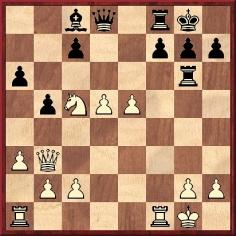
20...Qg5 21 Qf3 Qxe5 22 Rae1 Qd4+ 23 Qe3 Qxd5 24 Rf2 Bh3 25 g3 h5 26 Rd2 Qc6 27 Nd3 Re6 28 Ne5 Qb7 29 Qf2 Rf6 30 Qc5 Re8 31 Red1 Rf5 32 Qc6 Qa7+ 33 Kh1 Rfxe5 34 Rd8 Qe3 35 Rxe8+ Rxe8 36 Rg1 Bf5 37 White resigns.
Oscar Chajes – Boris Kostić‘Win missed by Kostić
Just before his departure for Europe, Boris Kostić had a prolonged sitting with Oscar Chajes at the I.L. Rice Progressive Chess Club of Manhattan, which ended in a draw after 91 moves. The three-cornered Chajes-Jaffe-Kostić series ended in favor of Chajes, 1½-½; Jaffe 1-1; Kostić ½-1½. The score of the game follows.’
1 e4 e5 2 Nf3 Nf6 3 Nc3 Bb4 4 Bc4 O-O 5 O-O d6 6 d3 Be6 7 Bb3 Nc6 8 Bg5 h6 9 Bh4 Bxc3 10 bxc3 Kh8 11 d4 Bxb3 12 axb3 Qe7 13 Re1 a6 14 d5 Nb8 15 c4 Nbd7 16 b4 g5 17 Bg3
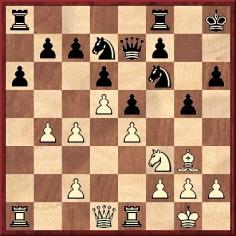
17...Nxe4 18 Rxe4 f5 19 Bxe5+ dxe5 20 Re2 Rae8 21 c5 e4 22 Nd4 Ne5 23 Ne6 Rf7 24 Ra3 Qf6 25 Rh3 Kg8 26 Rd2 Kh7 27 Kf1 c6 28 Rh5 Rg8 29 Ke1 Nc4 30 Re2 Rd7 31 Nd4 Rxd5 32 c3 Qg6 33 Rh3 g4 34 Rh4 Qg5 35 g3 Ne5 36 Qb1 Nf3+ 37 Nxf3
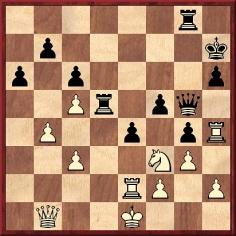
37...exf3 (‘Instead, as pointed out by Janowsky, Black might have won offhand and prettily by means of 37...gxf3 38 Rc2 Qxh4, and White dare not capture queen, on account of ...Rg1 mate.’) 38 Re3 Rgd8 39 h3 Kg7 40 hxg4 fxg4 41 c4 Rd4 42 Qa1 h5 43 Kf1 Kf6 44 Re1 Qf5 45 Kg1 Kg6 46 b5 cxb5 47 cxb5 Qxc5 48 bxa6 bxa6 49 Qxa6+ R4d6 50 Qa2 Qd5 51 Qc2+ Qd3 52 Qc5 Qd5 53 Qc2+ Kh6 54 Qc1+ Kg6 55 Qc2+ Kh6 56 Qc1+ Kh7 57 Qc2+ Kg8 58 Qc1 Qf5 59 Qc4+ Rd5 60 Re4 Rc8 61 Qa4 Rd2 62 Re1 Re2 63 Rd1 Rce8 64 Qc4+ Kh7 65 Qc3 R8e7 66 Qb4 R2e4 67 Qc3 Re2 68 Qb4 Kg6 69 Rc1 R2e4 70 Qd2 Qb5 71 Qd6+ R7e6 72 Qf8 Re8 73 Qd6+ R4e6 74 Qd2 Rc6 75 Ra1 Rce6 76 Qc2+ Kh6 77 Qc1+ Qg5 78 Qc3 Qe5 79 Qd2+ Kg6 80 Qc2+ Qe4 81 Qc5 Qe5 82 Qc2+ Kg7 83 Rd1 R8e7 84 Qc4 Rc7 85 Qa4 Rec6 86 Rh1 Rc2 87 Rh4 Rc1 88 Kh2 Rxd1 89 Qxd1 Qb2 90 Qe1 Kf8 91 Rxh5 Re7 Drawn.
Our correspondent concludes:
‘It is interesting to note the complete coverage given by Helms in the Eagle, and his total silence on the subject in the American Chess Bulletin. As regards the three-cornered masters’ tournament, with only three games played (not even a double round-robin), it must be the shortest on record.’
From John Donaldson (Berkeley, CA, USA):
‘George Koltanowski died on 5 February 2000, but a daily column bearing his name continued up to 27 February. On 28 February Shelby Lyman started and has appeared continuously to the present.’
Eli Hiltch (Ramat Gan, Israel) has drawn our attention to an on-line cumulated index of the Baker Street Journal, which enables us to clarify the Pillsbury matter discussed in C.N. 5257.
A story entitled ‘The Sherlock Holmes Opening’ by Richard Wincor was published on pages 92-94 of the June 1965 issue of the Baker Street Journal.
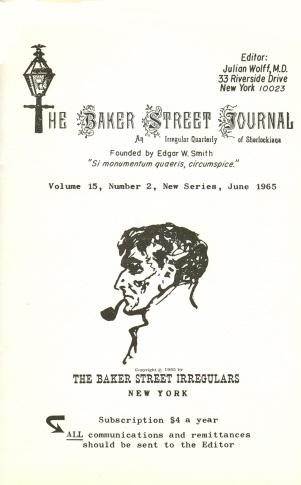
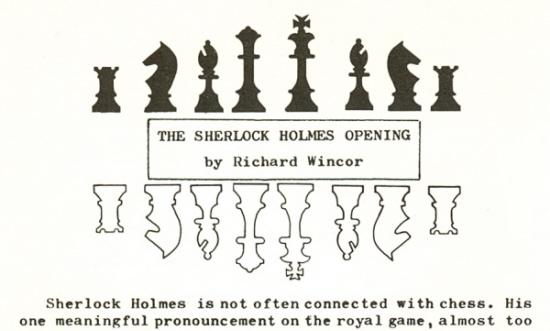
The item had nothing to do with Pillsbury but was a short story arising from ‘the case of Vigor, the Hammersmith wonder, mentioned in “The Sussex Vampire”’. Holmes took a board in a simultaneous display by the five-year-old prodigy Anton Vigorsky. All 100 opponents had the white pieces, and Vigorsky decided to put toxic Kafka Powder on their kings and queens, expecting the pieces to be chewed nervously during play. However, ‘absent-minded, like most geniuses’, he administered the poison to his own black pieces. And so: ‘Tonight it was Vigorsky who grew nervous. Sherlock Holmes was a match for him; the lad nibbled and chewed, then collapsed.’ Or, more graphically: ‘Vigor was turning green as he fell head first against his own battle forces, nose on the king’s rook.’
The article concluded with this game:
Sherlock Holmes – Anton Vigorsky1 d4 d5 2 e3 Nf6 3 Nd2 c5 4 c3 Nc6 5 f4 Bg4 6 Be2 Bxe2 7 Qxe2 e6 8 Ngf3 Be7 9 Ne5 O-O 10 O-O Ne8 11 Qg4 ‘Black swooned’.
The magazine (page 128) described Richard Wincor as ‘a practicing attorney and an expert on copyright law’. He later wrote Baroque Chess Openings (Boston, 1972).
In that same issue of the Baker Street Journal (pages 83-85) there was an article by Harold C. Schonberg (on Holmes and music, not chess), reprinted from the New York Times of 7 March 1965, and the fact that he had items published in both the Baker Street Journal and the Sherlock Holmes Journal in 1964-65 may explain why he confused the two publications when writing about Pillsbury in his book Grandmasters of Chess (C.N. 5257).
Referring to our article on Copying, Owen J. Clarkin (Ottawa, Canada) writes:
‘I should like to point out an example concerning:
(i) Modern Chess Openings, seventh edition, revised by W. Korn under the editorship of R.C. Griffith and P.W. Sergeant (London, 1946);
(ii) Practical Chess Openings by R. Fine (Philadelphia, 1948).
Regarding the Center Counter Game, I found that ten columns of variations and the corresponding footnotes are virtually identical. See pages 30-32 of MCO and pages 35-38 of PCO. Other chapters where copying is notable include the following:
Alekhine’s Defense: Columns 1 and 2 of MCO v 1 and 2 of PCO; column 23 of MCO v 20 of PCO; column 21 of MCO v 17 of PCO.
Bird’s Opening is practically identical for most variations and footnotes.
The Bishop’s Opening has many copied sections.
It is not clear to me who copied whom, or whether this copying has been noticed before. The editors of MCO credit Fine as the reviser of the sixth edition of MCO (see page v of the seventh edition), but Fine makes no mention in PCO of his involvement in the sixth edition of MCO.’
Our correspondent’s final paragraph holds the key to the affair: Reuben Fine had brought out a ‘completely revised’ edition of MCO in 1939. Below is part of the three books’ coverage of one of the above-mentioned openings:
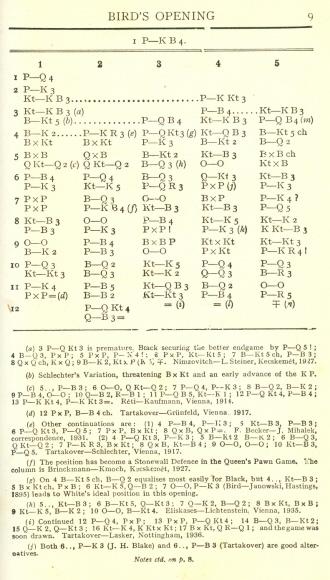
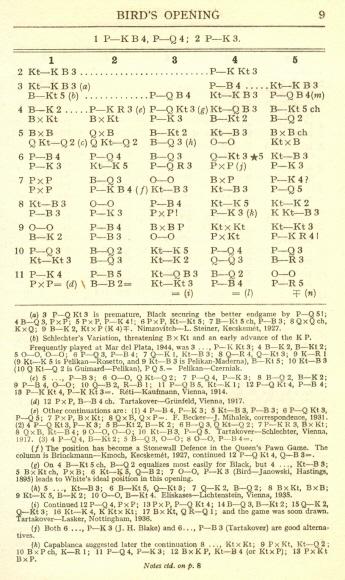
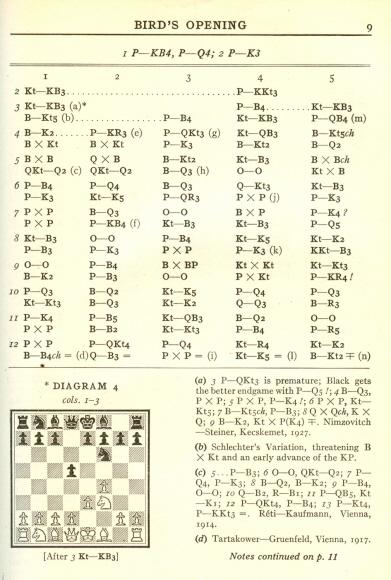
From left to right: MCO-6 by Fine (1939), MCO-7 by Korn (1946), Practical Chess Openings by Fine (1948)
Thus Fine’s material in the sixth edition of MCO was used both by Korn in the seventh edition of MCO and by Fine himself in PCO. The rights and wrongs of such practices seem far from clear-cut.
The following text appeared on the dust-jacket of Practical Chess Openings:
‘Several years ago, when the author was on an exhibition tour, the master of ceremonies in St Louis introduced him to the audience with the remark: “Ladies and Gentlemen, it gives us great pleasure to have with us tonight the author of the Bible.” The “Bible” that he referred to was Modern Chess Openings, sixth edition, to which this book is a sequel.’
The blurb also asserted: ‘Reuben Fine is the world’s leading authority on chess.’ As regards the MCO/PCO affair, Fine gave his side of the story on page 145 of his book Lessons from My Games (New York, 1958):
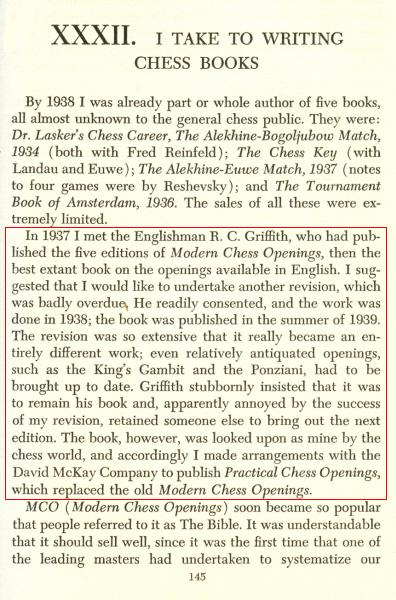
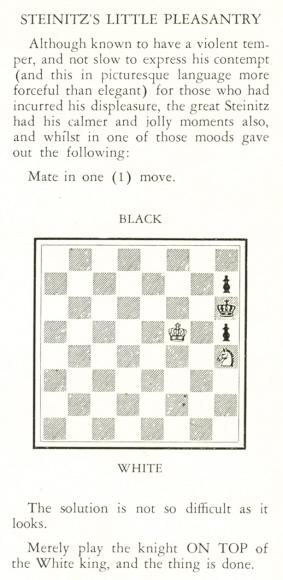
The above comes from page 39 of Chess Potpourri by Alfred C. Klahre (Middletown, 1931). What more is known about the ‘composition’?
From Mark N. Taylor (Mt Berry, GA, USA):
‘Dorothy Dunnett (1923-2001) wrote a series of historical novels with chessic titles, of which only the fourth in the series, Pawn in Frankincense (London, 1969), had actual chess content. Chapters 25–26 (pages 428-446 in the 1996 Vintage trade paperback edition) feature a deadly chess game with living pieces. There is enough specific description to plot out the opening moves, but not enough to reconstruct the entire game. Bill Marshall, a friend of the author, claimed that Dunnett had a diagram on which the endgame was based, but she died before she could locate it. In 1999 Marshall reconstructed the initial position and the early moves in “The Chess Game in the Seraglio”. The webpage has not been updated since; nor have I seen any further discussion about it. So the mystery remains: how did the game end? Was it based on a pre-existing endgame problem? If so, can it be identified?’
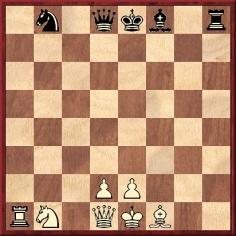
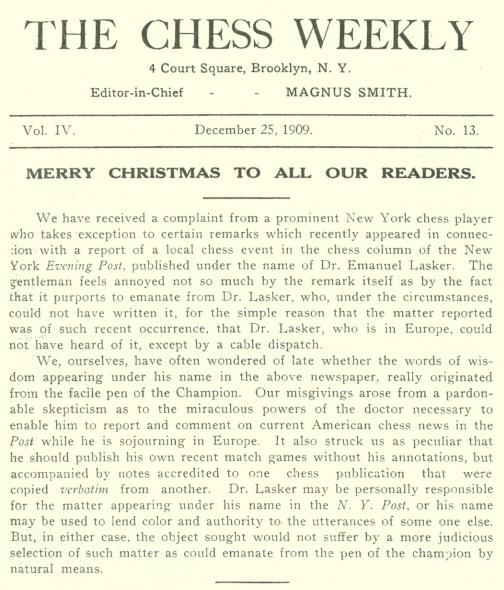
What facts are available regarding this suggestion that Emanuel Lasker’s column in the New York Evening Post may have been ghosted?
‘Efim Bogoljubow (1899-1952) was a chubby, bombastic drunkard known for his delusional thinking that he was invincible ...’
That comes from the very start of King’s Gambit by Paul Hoffman (New York, 2007), page ix. (‘1899’ is the book’s first date and is a decade out.)
Concerning the Alekhine v Bogoljubow world championship rivalry, page 297 of Learn from the Legends by Mihail Marin (Göteborg, 2004) states:
‘Ironically, Alekhine himself remarks in one of his comments to an emphatic win against his challenger: “This game is a clear hint about the pointlessness of the whole match”.’
We take that to be a rather simplified version of Alekhine’s observation (in his second volume of Best Games) about Bogoljubow’s 29th move in game four of the 1934 contest:
‘This game – more than any other – proves how useless from the sporting point of view was the arrangement of this second match, and at the same time explains my indifferent play on a number of occasions. I felt sure that Bogoljubow was no longer able to take advantage of the opportunities my play might present to him, and – very unfortunately for the general artistic value of the present match – the score 7 to 1 in my favour after the 22nd game fully justified my sanguine outlook.’
We should like to draw together any other comments by Alekhine, either at the time or afterwards, on the overall status, value or importance of the 1934 match.
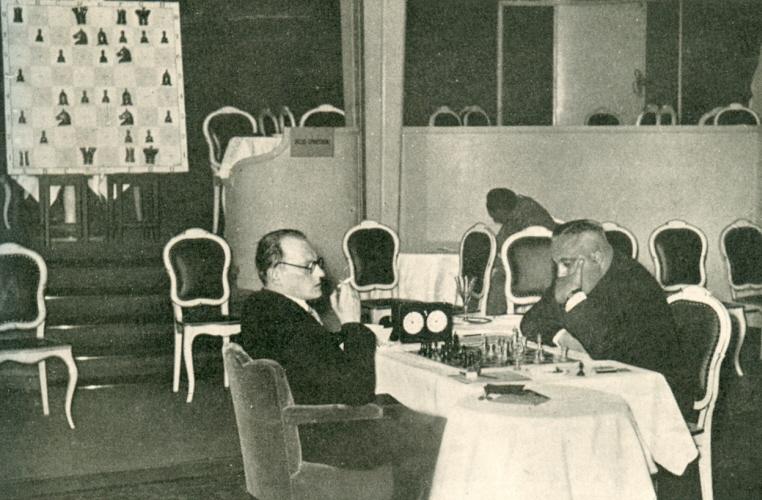
A. Alekhine v E. Bogoljubow, 25th match-game, Berlin, 11 June 1934
Page 490 of Alexander Alekhine’s Chess Games, 1902-1946 by Leonard M. Skinner and Robert G.P. Verhoeven (Jefferson, 1998) quoted a passage by Nimzowitsch in De Telegraaf, 1 May 1934 in which he reported on his conversation with Bogoljubow after the eighth match-game:
‘Apparently he believed that his performance in the match was being influenced by some hypnotic power brought about by Alekhine. In spite of being assured by Nimzowitsch that this was impossible, Bogoljubow insisted that it could be done. He seemed unable to comprehend that Alekhine was deliberately playing on his well-known sense of optimism in dealing with complicated tactical situations. Instead of defusing and simplifying the positions that Alekhine provoked, he aided and abetted Alekhine’s strategy by entering into the tactics with great enthusiasm.’
For further notes on hypnosis, see pages 170-171 of Kings, Commoners and Knaves. As regards optimism, it may be recalled from C.N. 832 (page 120 of Chess Explorations) that in an interview Bogoljubow stated:
‘People who know nothing about chess or character evaluation claim that I am an optimist. Quite the contrary, though, I am of a pessimistic nature. My wife always says (and quite correctly too), “Always expect the worst; if things then actually turn out better, you’ll be happy”.’
We quoted that passage from page 986 of L’Echiquier, March-April 1935, which mentioned that the interview had first appeared in Kasseler Neueste Nachrichten, 17 December 1932. Can a reader provide a copy of that original publication?
Javier Asturiano Molina (Murcia, Spain) asks about an article by Alekhine in Skakbladet after Nimzowitsch’s death.
C.N. 1931 mentioned the tribute, which was published in the May 1935 issue of the Danish magazine:
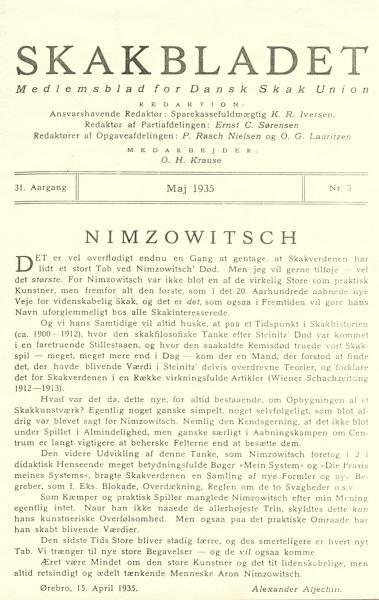
Mr Asturiano Molina also harks back to C.N. 3859, which gave an 18-move game published in 1896 and won by ‘Master Aron Niemzowitch, the nine-year-old son of a merchant of Riga’. Our correspondent asks if this is the same game that Nimzowitsch mentioned on page 8 of his autobiographical booklet Kak ya stal grosmeysterom (Leningrad, 1929), where he affirmed that his first published score appeared in the Rigaer Tageblatt and that he was eight and a half at the time (i.e. circa May 1895):

Michael McDowell (Westcliff-on-sea, England) quotes an item from the ‘Our Members’ column on pages 59-60 of The Problemist, January 1937:
‘Mr S.G. Luckcock began to play chess at the age of 21 and in a year or two won the “Championship” of a local chess club. He is now the present holder of the “Chess Amateur” Correspondence Championship for North London, which he won in April 1929, and the London and Middlesex Group C.C. since July 1935.
He took up correspondence play because his business did not give him time to belong to a Club, even locally.
He is a quick solver and very rarely sets up a position, but likes solving from the printed diagrams.
Here is one of his interesting reminiscences:
“I was playing with several others against Mr Blackburne in simultaneous chess one evening. We had our score sheets by our side, when a gentleman tapped me on the shoulder saying he would like a word. He asked me if I was S.G. Luckcock, the problemist. I said that no-one had called me that until now but that I had published a few. He said, ‘I am glad to know you for I am the Chess Editor you submit them to’, and it was I. Gunsberg speaking. He introduced me to his son Alfred, a lad about my own age, who afterwards married my eldest sister: through this connection I met Mason, Dr Lasker, Lee, Marshall, Pillsbury, Teichmann and many others famous in those days and at the Divan Café played singly against Gunsberg and Marshall, losing both my games, of course, but this gave me a great enthusiasm for the game and, as I got to play better, I lost my power to compose problems.”’

This photograph was published on page 167 of CHESS, May 1951 and shows H.E. Atkins giving a 12-board simultaneous display in Leicester.
David Lovejoy (Mullumbimby, NSW, Australia) notes that chess sources are inconsistent as to the publication date of Tartakower’s Die Hypermoderne Schachpartie and asks for clarification of the correct year.
The usual options (1924, 1924-25 and 1925) all seem valid, although we now tend to regard 1924 as the best choice. There were two editions of the book, dated 1924 and 1925:
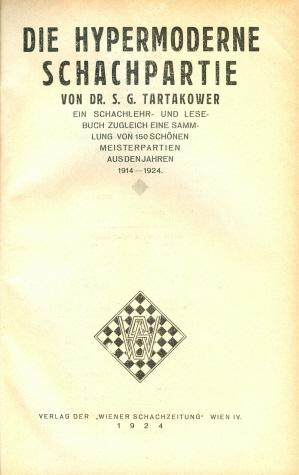
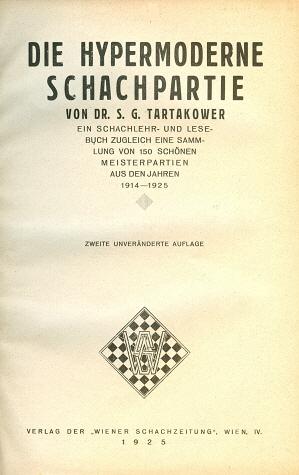
The latter (‘zweite unveränderte Auflage’ – the second unaltered edition) was reproduced by Edition Olms, Zurich in 1981.
In addition, our collection contains instalments 1-6 of the book (pages 1-384), all of which are dated 1924.
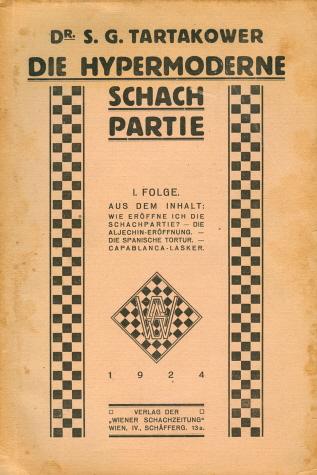
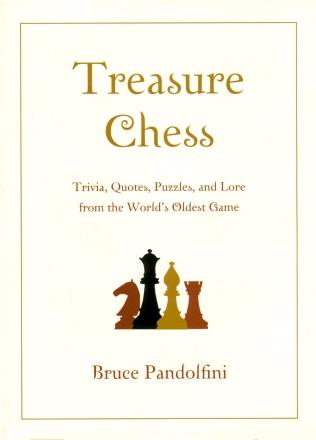
There has been a recent spate of ‘prose’ chess books woefully lacking in rigour, and the worst may well be Treasure Chess by Bruce Pandolfini (New York, 2007). ‘Trivia, Quotes, Puzzles, and Lore from the World’s Oldest Game [sic]’ is the subtitle, while the acknowledgements page begins with similar insouciance:
‘For a book like Treasure Chess it is not so easy to cite where all my references and impressions came from, so I’m not even going to try.’
Since much of the information provided is false, supplying citations would indeed have been awkward. Yet Pandolfini has not even made an effort regarding simple dates, whose margin of error ranges from a year (Capablanca’s birth, on page 75, and the publication date of Murray’s A History of Chess, on page 171) to a century or so (the founding of the American Chess Magazine, on page 67). Page 202 indicates that Marcel Duchamp lived to be 97 (‘1871-1968’), and it is all hit and miss. Thus whereas Morphy’s birth and death dates (1837 and 1884) are given correctly on page 67 (twice, in fact), page 20 states ‘1836-84’, while page 96 has the right digits but in the wrong order: ‘1843-87’.
Also concerning Morphy, page 60 affirms that ‘he was regarded as [US] champion until 1871’, and page 264 has the following fact-free ‘Fun’:
‘Paul Morphy did various inexplicable things, such as placing women’s shoes in a semicircle around his bed before going to sleep.’
According to page 60, Marshall was US champion from 1909 to 1935, but page 72 says that he held the title for 29 years. Then there is Pandolfini on Tal (page 79):
‘His intuitive feel for the art of inscrutable sacrifice was difficult to play against, though chess fans loved it. Finally they had a champion they couldn’t understand, whom they understood.’
Inscrutability is a characteristic of the book’s pseudo-didactic parts. For example, the ‘Tools of the Trade’ section includes such advice as the following (pages 12-15):
Page 158 claims that ‘purists use [the term Zugzwang] to indicate positions where neither player wants to move, though in general chess parlance it also means that a particular player doesn’t want to move’, but no such mysterious purists are identified. Plain English does not come naturally to Pandolfini, even in his explanations of basic chess terms. On page 15 the skewer is defined thus: ‘Attack forcing an enemy unit off a line, exposing a unit or square.’ Nor is he comfortable with other languages. Page 174 refers to ‘La Palamede’, instead of Le Palamède, while page 253 unsuccessfully attempts to give the word ‘chess’ in seven random foreign languages (including ‘Scacci’ in Italian and ‘Schak’ in Danish).
History, of course, is mangled. Page 63 states that Capablanca made perfect scores at tournaments in New York in 1913 and 1914, but the Cuban participated in no tournaments in New York in 1914. Pandolfini even believes (pages 102-103) that Capablanca’s famous exhibition game in Moscow against Ossip Bernstein (29...Qb2) was played in the St Petersburg, 1914 tournament. Spurious games are attributed to Napoleon (pages 92-94). Page 166 reports that chess was probably created in A.D. 450 and that the board became chequered in A.D. 110. The latter date, of course, is just one more typo.
The book’s treatment of quotations could hardly be worse. Napoleon’s name is somehow dragged in again on page 272 for this description of chess: ‘Too difficult to be a game, and not serious enough to be a science or an art.’ On page 234 the remark about life being too short for chess is ascribed to both Lord Byron (1788-1824) and Henry James (1843-1916), instead of Henry James Byron (1835-1884).
The imprint page of Treasure Chess warns, ‘No part of this book may be reproduced in any form or by any means’, and anyone who cares about accuracy and truth will unhesitatingly comply.
From Steve Wrinn (Homer, NY, USA):
‘With regard to Ernst Klein and his involvement with the 1935 world championship match, and in particular his expulsion from the playing-hall during the 28th game, here are two quotes from books on that match.
1) The first comes from Recueil des parties du championnat du monde (Alekhine-Euwe) 1935, (Brussels, undated). The introduction to the 28th game (page 82) strongly suggests that Klein’s status as Alekhine’s “trainer” was unofficial:
“La fièvre monte. Le maître Alekhine, avec les Noirs, joue une variante suggérée par Spielmann et développée par le jeune maître viennois Klein, qui vient d’en faire une étude approfondie durant une huitaine de jours, suivant ses propres déclarations. Sans motifs apparents, le maître Klein se trouve aux côtés de l’ancien champion du monde. Au quinzième coup, Alekhine estimant sa position satisfaisante va serrer la main de celui que l’on a nommé – peut-être à tort – son ‘entraîneur’; ce geste soulève un incident au cours duquel le maître viennois est prié de quitter les lieux indûment occupés par lui.”
2) Hans Kmoch, in his Tagebuch vom Wettkampf Aljechin-Euwe (Vienna 1936), does not mention Klein by name but does refer to an incident during the 28th game in which a young chess master was asked to leave the playing-hall. The result was physical violence and police intervention. On pages 70-71 Kmoch wrote:
That last sentence leads me to believe that more information on the incident may well be available in contemporary sources, particularly in the Netherlands.’“Im Laufe des Abends ereignete sich leider ein unerfreulicher Zwischenfall. Ein junger Mann, ein Ausländer, Schachspieler mit beginnendem Renommee, dem Wettkampf mit Pressekarte beiwohnend, widersetzte sich hartnäckig einer Anweisung des Komitees, obwohl die diesbezügliche Pflicht auf den Pressekarten ausdrücklich vermerkt stand und für den Widersetzungsfall der Entzug der Pressekarte angedroht wurde. Als sich nun der Besagte durchaus nicht fügen wollte, wurde er von einem Mitglied des Komitees aufgefordert, seine Pressekarte abzuliefern und das Gebäude zu verlassen. Diese Aufforderung beantwortete der Unglückselige damit, daß er den betreffenden Herrn mit der Faust ins Gesicht schlug. Der “rasende Reporter” wurde schließlich polizeilich abgeführt.
Der peinliche Vorfall spielte sich zwar unter Ausschluß der Oeffentlichkeit ab, gelangte aber doch in die Presse und konnte daher an dieser Stelle nicht übergangen werden.”
Mr Wrinn also draws attention to the following remark by Emanuel Lasker:
‘Bogoljubow, it seems, believes in the art of subjecting one person to the will of another by some extraordinary power. Can such an art exist? Decidedly no. If it did exist and someone set himself up as a teacher of this art, he would have the whole world for his customers and yet derive no advantage therefrom, because his pupils would hypnotize him and then suggest to him the return of the tuition fee.’
This comes from page 11 of Lasker’s book Games Played in the Return Match for the World’s Championship (London, 1935), and for the context we reproduce below the full page:
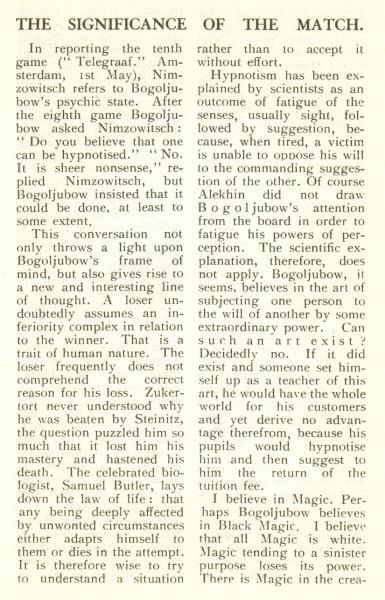
Jon Crumiller (Princeton, NJ, USA) sends a cutting from page 4 of the Wisconsin publication the Whitewater Register of 31 July 1858. Readers are naturally advised to treat it with great prudence.
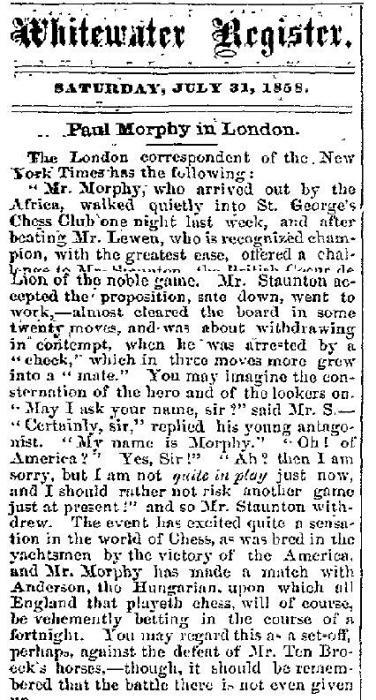
From pages 5-6 of Chess World, 1 January 1950:
‘In 1913, the Melbourne Leader conducted a problem-solving competition, with extra points for “cooks”, “duals”, proofs of impossibility and so on. There were many real problemists in Australia then, and great solvers, a vanished band. The star solver was “Petros” (Dr Bennie).
One three-er of [C.G.] Watson’s had been cooked by Petros. Smarting under this set-back, Watson composed the three-er here diagrammed.
Mate in three.
It was a huge success, as Petros wrote claiming no solution; also that the position was impossible. Both claims were wrong. There was only one correct solver – the late Henry Tate.’
The solution was given as follows on page 24:
‘First of all, it can be absolutely proved that Black’s last move must have been either ...P(B2)-B4 or ....P(K2)-K4.
The solution is 1 PxQBP e.p. or 1 PxKP e.p. This is not a dual solution as of course Black cannot have laid himself open to both en passant captures, but only either one or the other.
No wonder this masterpiece of ingenuity hoodwinked the cognoscenti.
An en passant key is not permitted unless it can be demonstrated that Black’s last move was a double pawn hop.
The sole solver’s comment was published. It ran:
“An astonishing bifurcated Siamese twin double-barrelled wonder ... The retrospective double singular key seems to be bullet-proof.”’
Joose Norri (Helsinki) writes:
‘There are indeed “purists” who make a distinction between the two types of Zugzwang. In issue 29 of EG David Hooper defined Zugzwang and squeeze. The difference is clearly more important in studies.’
It will be seen that David Hooper’s detailed article referred to his definition of Zugzwang on pages 196-197 of A Pocket Guide to Chess Endgames (London, 1970). Our inscribed copy includes his handwritten errata sheet, dated 4 September 1971, and readers wishing to receive it are invited to contact us.
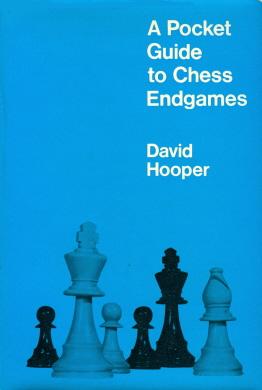
More information is sought on this game:
Allies – Emanuel Lasker1 e4 e5 2 Nf3 Nc6 3 c3 d5 4 Qa4 dxe4 5 Nxe5 Qd5 6 Nxc6 bxc6 7 Bc4 Qd6 8 O-O Ne7 9 Qb3 Qg6 10 Re1
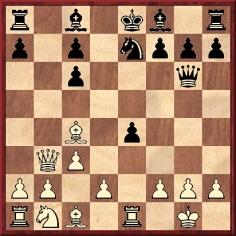
10...Bh3 11 g3 Rd8 12 d4 Nd5 13 Nd2 f5 14 Nf3 Bd6 15 Bg5 Qh5 16 Bxd8 Qxf3 17 Bf1 Bxf1 18 Kxf1 e3 19 Qc2 Kxd8 20 Kg1 f4 21 White resigns.
Source: American Chess Bulletin, November 1919, page 249.
The Bulletin did not name the allies and merely said that the game had been played ‘recently’. We have not found the score in the Schweizerische Schachzeitung.
On page 7 of the January 1920 issue of the American Chess Bulletin Hermann Voigt of Philadelphia stated that Lasker’s 10...Bh3 was questionable, as it could have been met by 11 Bxf7+ Qxf7 12 Qxf7+ Kxf7 13 gxh3, after which the e-pawn cannot be saved.
C.N. 4942 referred to a report that, in a game against Sir George Thomas, Dawid Janowsky resigned by writing ‘abandonnent’ in the adjournment envelope. No occasion was specified in the report, but Janowsky’s only loss to Sir George Thomas was apparently at Marienbad, 1925.
Now, a passage on page 49 of The Delights of Chess by Assiac (London, 1960) has come to our attention:
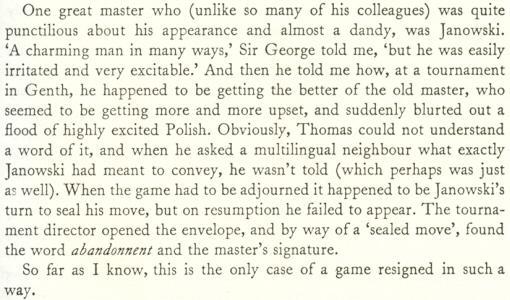
The two masters played each other twice in a 1926 tournament in Ghent, but both games were drawn.
Information is still lacking regarding Rudolph Pokorny, who starred in The Capablanca-Pokorny Fiasco. A player named Pokorny participated in the 1919-20 Manhattan Chess Club Championship (American Chess Bulletin, April 1920, page 71), finishing last with half a point, and his loss to R.T. Black was published on page 7 of the January 1920 issue. However, nothing has yet been found concerning his identity.
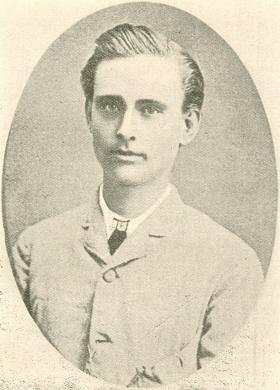
This exceptional chess figure will be discussed in the next C.N. item.
An obituary on page 217 of the 21 July 1905 issue of La Stratégie described his talent as ‘un phénomène extraordinaire’, while pages 330-331 of the August 1905 BCM stated that ‘the loss to the chess world is irreparable’ and a ‘calamitous event’, yet most chess encyclopaedias are without an entry for him. Even so, he is by no means forgotten in general chess literature and received recognition on, for instance, pages 7 and 63 of Wonders and Curiosities of Chess by Irving Chernev (New York, 1974).
He died at the age of 43, having been blind for nearly a decade, and below we provide some brief notes on the man of whom A.C. White wrote (Lasker’s Chess Magazine, July 1905, pages 121-122), ‘as a problemist he is without a peer’ and whom page 250 of the July 1905 American Chess Bulletin called ‘the greatest composer of two and three movers combined that ever lived’. He was Arthur Ford Mackenzie (1861-1905), who was born and died in Kingston, Jamaica. A.C. White’s above-mentioned tribute noted that his death was already announced in 1896 (see page 323 of A Chess Omnibus) and that:
‘This stricken invalid, fighting year after year against blindness and ill-health, seeing, one by one, all earthly ambitions and hopes extinguished, nevertheless stands out as a noble figure, universally sympathized with, universally admired and universally mourned.’
The highest praise also appeared on pages 278-279 of the August 1905 American Chess Bulletin, which was the source of the photograph of Mackenzie given in C.N. 5289.
The BCM obituary mentioned that ‘when still at school Mr Mackenzie conducted a chess column in the Family Journal, of Kingston, Jamaica ...’ In 1887 he brought out in Kingston a large volume, Chess: Its Poetry and Its Prose, our copy of which has a sales slip dating from the year of publication:
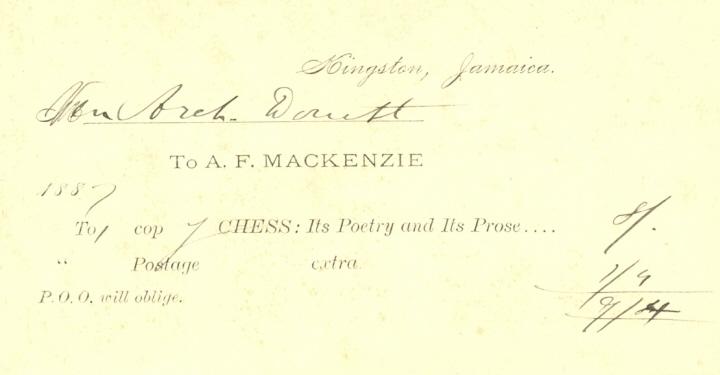
The book’s title was explained by Mackenzie on page 3:
‘As practical play is the Prose, so is problem composition the Poetry of Chess, and a single problem of the modern school can be made to yield in its solution more of chess truth and beauty than an ordinary player will enjoy in a lifetime.’
The book does not contain chess literature’s most digestible prose, but Mackenzie’s annotations to his problems were marked by critical objectivity. A separate 34-page section ‘The Elements of Chess’ dealt with over-the-board play and gave, on pages 32-33, this game:
James Leslie Main – Arthur Ford Mackenzie1 e4 c5 2 d4 cxd4 3 Qxd4 Nc6 4 Qd1 e5 5 Bc4 Bc5 6 Nf3 Nf6 7 Ng5 O-O 8 c3 h6 9 b4 Bxf2+ 10 Kxf2 hxg5 11 Nd2 d6 12 Re1 Ng4+ 13 Kg3 Qf6 14 Nf3
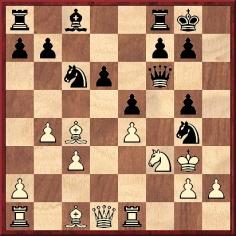
Black announced mate in three: 14...Qf4+ 15 Bxf4 exf4+ 16 Kh3 Nf2.
The volume ended with a ‘list of preliminary supporters’ (more than three pages) which included Lord Randolph Churchill, Samuel Loyd, Charles Maurian and Sir Robert Peel. Mackenzie’s posthumous book Chess Lyrics (New York, 1905) was brought out by A.C. White, and a brief supplement was published the following year.
As an example of Mackenzie’s output we pick from page 301 of Chess: Its Poetry and Its Prose a problem which he contributed to the Chess Monthly, June 1884, page 317:
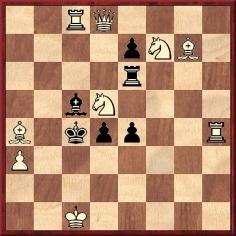
Mate in two.
An addition to our feature article Early Uses of ‘World Chess Champion’ comes from page 613 of Harper’s Weekly, 25 September 1858 (an article entitled ‘Paul Morphy, Esq., The Chess Champion of the World’):
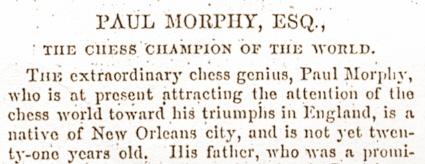
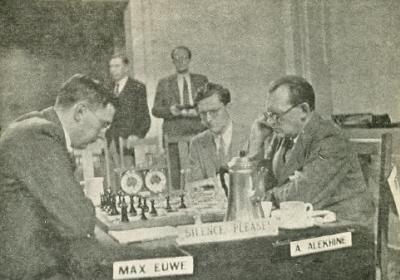 From Oliver Beck (Seattle, WA, USA):
From Oliver Beck (Seattle, WA, USA):
‘In a bookstore I recently came across two boxes of books and other rare and interesting chess material which once belonged to Paul Hugo Little (Litwinsky). C.N. 4935 showed him at the board with Euwe and Alekhine during their game at Nottingham, 1936, in a photograph taken from Chess Review, and I wonder if he was seated there as an indirect result of the disturbance created by Euwe and others during the Flohr v Capablanca game in the third round (see A.J. Mackenzie’s comments on page 3 of the tournament book, as well as Alekhine’s note to Capablanca’s 37th move on page 59), although he may have received that privilege through his donation of prizes (page xiv). I am interested in learning more about this incident, which may have cost Capablanca sole possession of first place.
Little, who died in 1987, was an interesting character. His many notes in the material I acquired show him to have been a stickler for detail and accuracy. For example, among the newer books is a copy of With the Chess Masters which was signed and dedicated to him by George Koltanowski. This, however, did not stop Little from correcting it throughout with a ballpoint pen, finding many of the errors you pointed out on page 160 of Chess Explorations.’
Below are the passages by Alekhine and Mackenzie referred to by our correspondent:
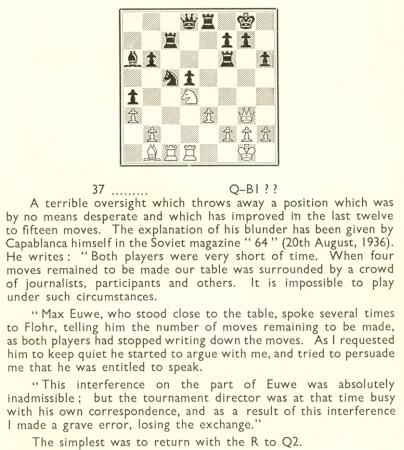
Above: from Alekhine’s notes to
Flohr v Capablanca, in the Nottingham, 1936 tournament book
(with incorrect diagram)
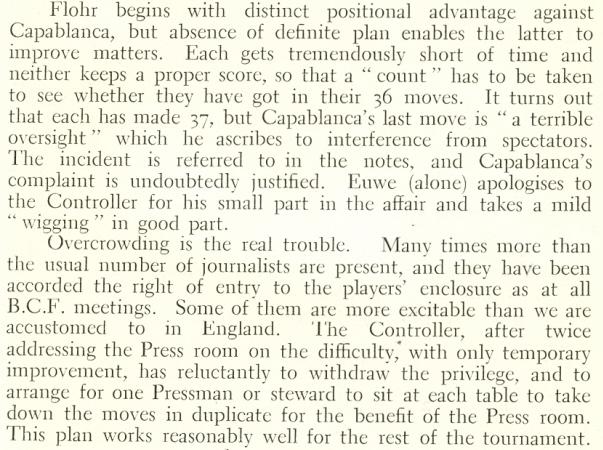
From A.J. Mackenzie’s
round-by-round commentary in the Nottingham, 1936 tournament
book
An English translation (by Kenneth Neat) of all Capablanca’s notes to the Flohr game on page 2 of the 20 August 1936 issue of 64 appeared on page 279 of our book on the Cuban. Moreover, C.N. 211 mentioned that on page 166 of The Great Chess Tournaments and Their Stories (Radnor, 1975) A. Soltis expressed unjustified doubts about the account:
‘The only problem with Capablanca’s version of the incident is that the time limit was 36 moves in two hours, not 40. This would mean that Black’s blunder came after the time control.’
There is, though, a simple explanation. C.N. 211 quoted from page 314 of the Australasian Chess Review, November 1936:
‘The players were now so clock-pressed that they had not even been able to write down their last few moves. At any rate, Capablanca had not. Therefore, he did not know that he had made his 36. Hence this clock-blunder when the race was actually over.’
See also pages 432-433 of the September 1936 BCM and, in particular, the note to 37...Qc8:
‘Both players were so short of time they did not even know how many moves they had made. This explains the repetition of moves, and also their meaningless manoeuvres; and also how it happened that Black made a mistake when the time-limit was finished.’
As regards P.H. Little, when still in his teens he had chess poetry published (American Chess Bulletin, September-October 1934, page 127 and December 1934, page 162). He later wrote non-chess fiction (under pseudonyms) and non-chess non-fiction. In the latter category we own an inscribed copy of The Juvenile Delinquent (New York, 1971), which had a five-page Introduction by Reuben Fine.
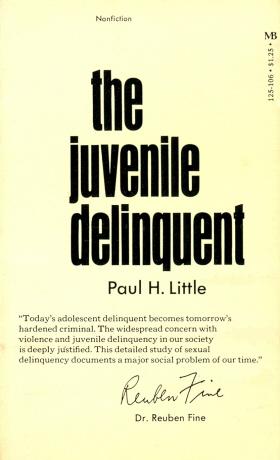
Yasser Seirawan (Amsterdam) asks:
‘What hard facts are available regarding the chessplaying strength of Marshal Tito of Yugoslavia?’
We throw the question open to readers and offer, in the meantime, two photographs:
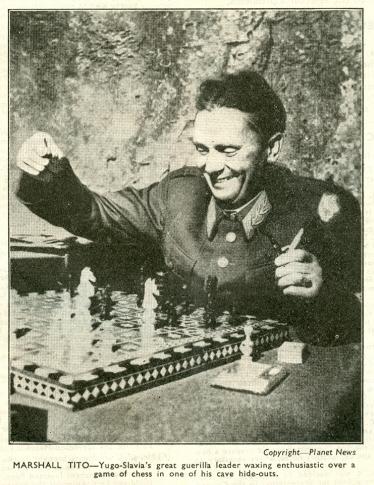
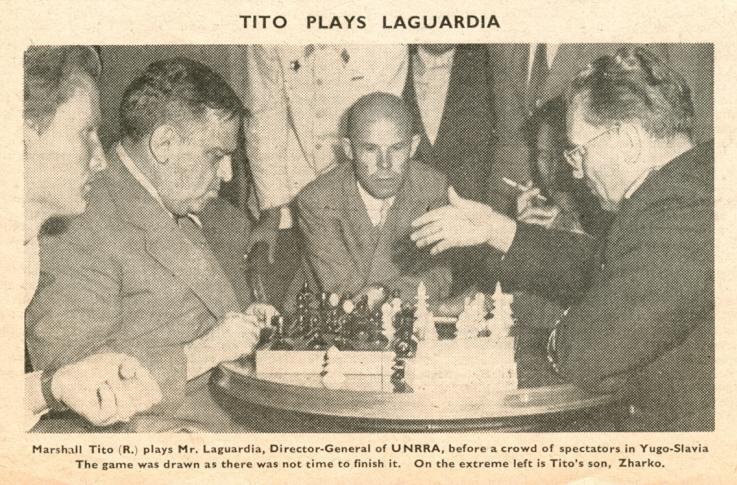
The pictures appeared in CHESS, in November 1944, page 17, and September 1946, page 285 respectively. The first photograph was included in a set of four on page 233 of Persönlichkeiten und das Schachspiel by B. Rüegsegger (Huttwil, 2000).
Robert John McCrary (Columbia, SC, USA) offers an early use of the term ‘key’ referring to compositions (‘situations, or ends of games’), from page xxix of volume one of J.H. Sarratt’s A Treatise on the Game of Chess (London, 1808):
‘These situations will not greatly improve amateurs, unless they attempt to find out the method of winning without looking at the solution; the author has therefore deemed it eligible to insert the situations in the first volume, and the solutions in the second: and he earnestly recommends amateurs to seek diligently for the proper moves, without having recourse to the key ...’
Our correspondent comments:
‘The term “key” here may simply mean the list of answers, but this could have transferred to its modern sense of key move.’
Gábor Gyuricza (Budapest) writes:
‘Page 10 of the 1964 booklet Le gambit de Budapest by Jacques Le Monnier mentions the following game: 1 d4 Nf6 2 c4 e5 3 dxe5 Ng4 4 e4 Nxe5 5 f4 Ng6 6 Be3 Bb4+ 7 Kf2 Qe7 8 Nf3 (if 8 Qd5 d6) 8...Nc6 9 Qd5 b6 =+ (“Chéron-Alekhine, Vevey, 1925”). I find that quite strange because a) I have never seen the game published anywhere else and b) Alekhine liked to play this variation with White but not with Black. Can full, correct information about the game be found?’
Harrie Grondijs (Rijswijk, the Netherlands) sends this game, played by Leo Tolstoy’s son Sergius/Sergei, which was published on page 387 of Shakhmatny Zhurnal, December 1900:
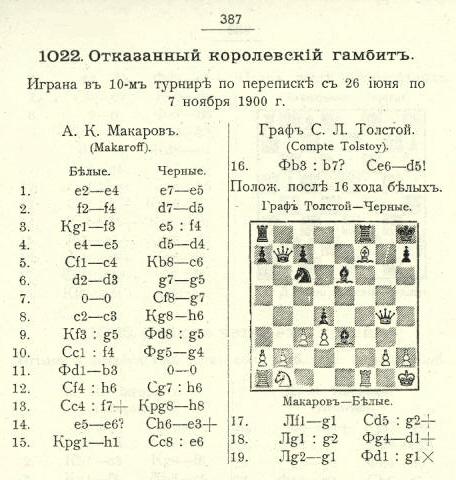
From various Portuguese and Brazilian websites we note that Trompowsky’s forename takes an acute accent on the a: Octávio.
Pete Tamburro (Morristown, NJ, USA) asks why, in his Spirit of the Times chess column, Charles H. Stanley used the title Chess Player’s Magazine when referring to the periodical that he edited (1846-47), whereas it is commonly known as the American Chess Magazine.
Both titles were used. ‘The American Chess Magazine’ appeared on the cover, as shown, for instance, on page 82 of David DeLucia’s Chess Library. A Few Old Friends (Darien, 2003), whereas ‘The Chess Player’s Magazine’ was the headline on the journal’s pages.
A reprint of the Magazine was produced by the Publishing House Moravian Chess, Olomouc in 1999.
Jon Crumiller (Princeton, NJ, USA) submits this announcement of a blindfold exhibition by Philidor on the front page of the (London) Times of 25 February 1790:
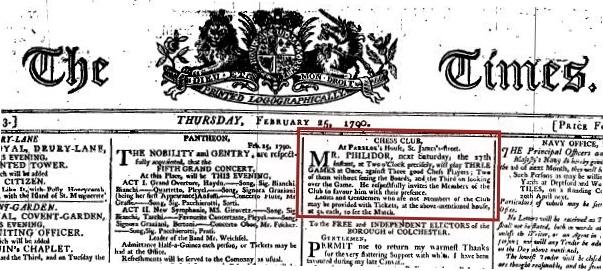
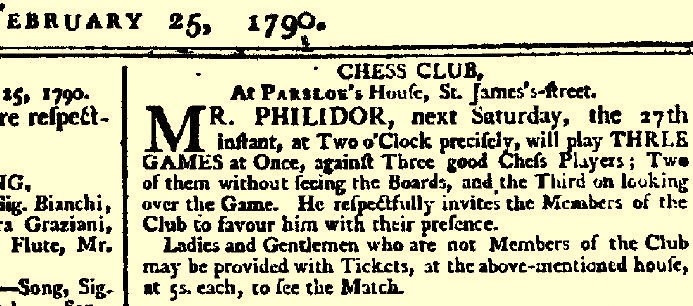
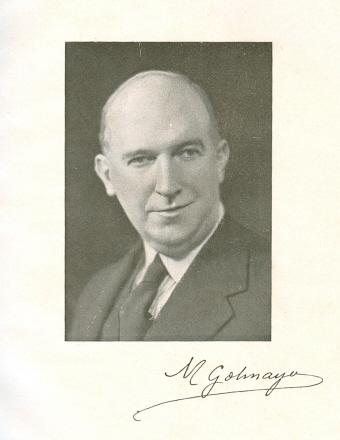
Manuel Golmayo
To our list of persons who wrote books on both chess and bridge Josep Alió (Tarragona, Spain) adds Manuel Golmayo de la Torriente (1883-1973). He brought out two chess books, Temas de ajedrez (Madrid, 1940s – no exact year) and Temas clásicos de ajedrez (Madrid, 1966 and 1969). Our correspondent mentions that Golmayo was also a strong bridge player and the author of Bridge contratado (Madrid, 1946):
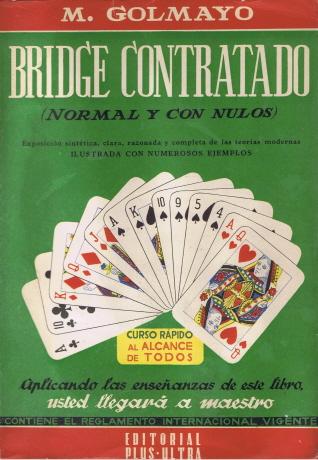
From Martin Weissenberg (Savyon, Israel):
‘In his book Dykteryjki i ciekawostki szachowe (Warsaw, 1971; second edition, Warsaw, 1974) the Polish chessplayer and author Władyslaw Litmanowicz gave an account of his visit to Akiba Rubinstein in June 1957, at an old people’s home in Brussels (“Maison de retraite pour vieillards – A.S.B.L.”).
He stated that Rubinstein had arrived there two years earlier, after the death of his wife, and lived in a room for eight, sharing with two persons. Though surprised by the unexpected visit, Rubinstein received his guests dressed in a well-tailored suit, with the appearance of an elegant elderly gentleman. He sported a large beard, and invited his visitors to speak in the language of their choice: Polish, Russian, German or French.
Litmanowicz conveyed to Rubinstein the greetings of Kazimierz Makarczyk and Marian Wróbel, and informed him of the recent deaths of Tartakower, Regedziński and Důras. Rubinstein was not aware of Smyslov’s victory over Botvinnik for the world championship and refused to play a game against his guest. He did, however, analyse two studies by Důras with much interest.
After leaving the old people’s home, Litmanowicz was told by C. Rubin-Zimmer, the nurse who devotedly looked after Rubinstein, that he was in very good health considering his age, and was very quiet and restrained, notwithstanding several oddities: sometimes he refused to leave his room, or to go to bed to sleep. In such cases he sat on a chair near his bed, thinking deeply about something, or moving pieces on his pocket chessboard.’
John Blackstone (Las Vegas, NV, USA) sends the obituary of S. Lipschütz in the New York Times, 5 December 1905, page 9:
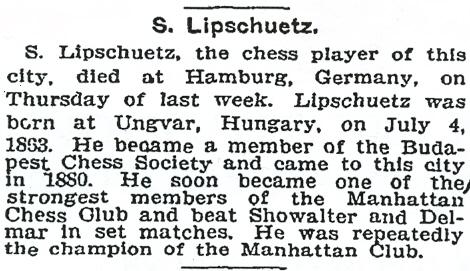
Our correspondent notes, in particular, that 1880 is given as the year of the master’s arrival in New York.
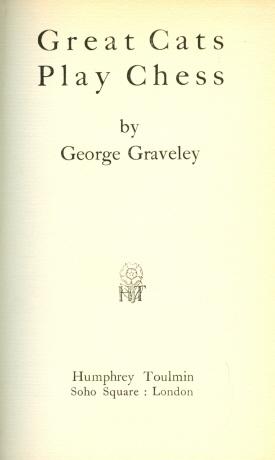
Great Cats Play Chess by George Graveley (London, 1935) is a three-act play, set in 1662-63, which has nothing to do with either cats or chess. The title is a double metaphor for the romantic scheming which involved the Countess of Castlemaine and Frances Teresa Stuart vis-à-vis King Charles II of England.
Our copy of the book, which seems to be very rare, was inscribed by Graveley to the English actress Margaretta Scott (1912-2005).
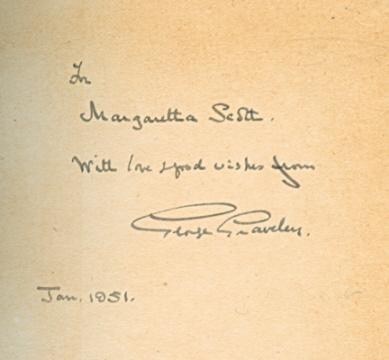
Concerning the remark about chess by a character (Talbot) in the ‘original modern comedy’ Our Boys by Henry James Byron (1835-1884), the full passage is reproduced below, from Act I:
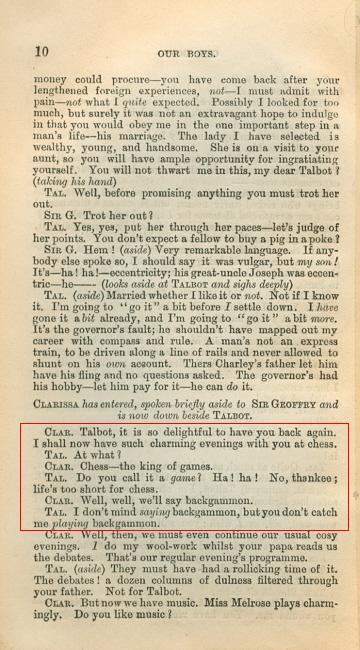
In book form we have various editions of the play, which received its première at London’s Vaudeville Theatre on 16 January 1875, ran until 18 April 1879 and was promoted as ‘the most successful comedy ever produced’. None of the nineteenth-century volumes in our collection is dated. When mentioning Our Boys in a footnote on page 270 of A Chess Omnibus we gave ‘1880’, that being the British Library catalogue’s earliest date for any published edition of the play.
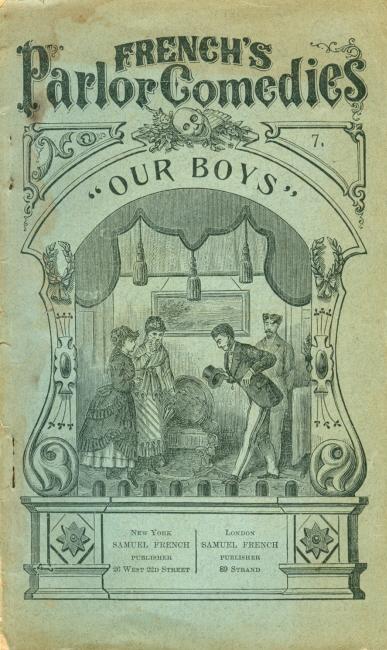
For background information on Byron, as well as the complete text of Our Boys, a valuable book is Plays by H.J. Byron edited by Jim Davis (Cambridge, 1984). The Introduction (page 1) mentions that Byron was ‘the most prolific playwright of the mid-Victorian period’, that he invented the pantomime characters of Buttons and Widow Twankay and that the four-year run of Our Boys broke all known records.
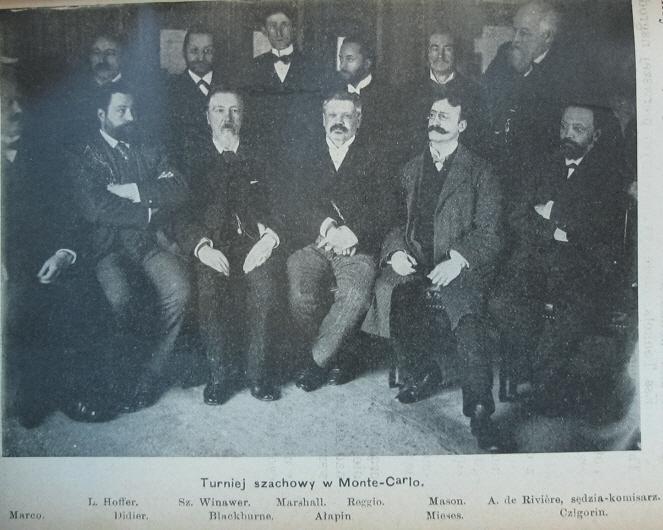
Tomasz Lissowski (Warsaw) submits the above group photograph of Monte Carlo, 1901, published in that year’s Sport, a Polish weekly periodical. He asks whether a copy of better quality can be obtained.
| First column | << previous | Archives [40] | next >> | Current column |
Copyright 2007 Edward Winter. All rights reserved.